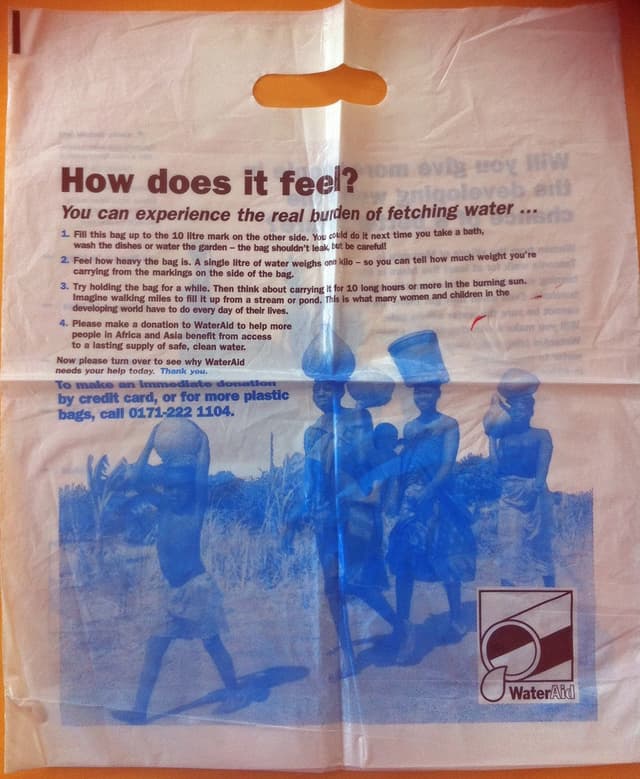WaterAid’s plastic bag mailing
- Exhibited by
- Carolina Herrera, project manager, SOFII.
- Added
- August 07, 2011
- Medium of Communication
- Direct mail
- Target Audience
- Individuals
- Type of Charity
- International relief / development
- Country of Origin
- UK
- Date of first appearance
- 1997
SOFII’s view
This is a brilliant involvement device and a direct mail first. This mailing deserved to do very well because of its sheer appropriateness and its potential for engaging the donor by introducing them to the real meaning of what it must be like to have to walk several miles each day to collect water for your family’s needs. This mailing has the wow factor, in bucket-loads.
Creator / originator
Burnett Associates Limited. The team behind the idea was Derek Humphries, Jason Potts and Simon Robinson.
Summary / objectives
This was a warm mailing to donors asking them to make a special gift. It was created to give maximum impact by using a format never before used in a fundraising direct mail and which, to its credit, breaks all the rules. Water is heavy, awkward, not easy to carry. Every day in developing countries thousands of women (mainly) face the difficult task of fetching and carrying water from its source to their homes. It's a gruelling daily duty most donors would find very hard to imagine. Could this concept be applied imaginatively to a fundraising appeal? WaterAid believed it could so responded positively when its agency at the time, Burnett Associates, came up with the unusual idea of printing the entire mailing pack on both sides of a plastic bag. Readers were asked to part fill the bag with water, then to see for themselves how difficult it is to carry. Given that this mailing breaks all the rules it was a brave decision from WaterAid to try it. But sometimes rules should be broken, don't you think?
Background
This was a creative test of a new style of involvement device.
Special characteristics
The main part of the mailing was printed on a plastic bag and wrapped with a simple paper wrapper which carried the recipient's name and address, an explanatory letter and the reply form.
Details
It wasn’t tested in advance.
Costs
Not known.
Results
It performed better than a standard warm appeal and, not surprisingly, received one or two more complaints than a standard warm appeal too. Derek thinks the complaints were from people who had already realised that plastic bags were the devil’s work (they must have been a bit ahead of the reusable sisal bag curve).
It would have been interesting to see it used as a cold recruitment piece, but sadly the client got cold feet after the complaints.
Merits
It is inspirational, innovative and involving. It will inspire others to be equally inventive.
Other relevant information
WaterAid didn’t have to worry too much about recruitment in those days as each year the UK water industry gave it a free insert in the nation’s water bills which brought in 15,000 committed givers every year.

 View original image
View original image
Also in Categories
-
- The Ken Burnett archive
- Individual donors

















